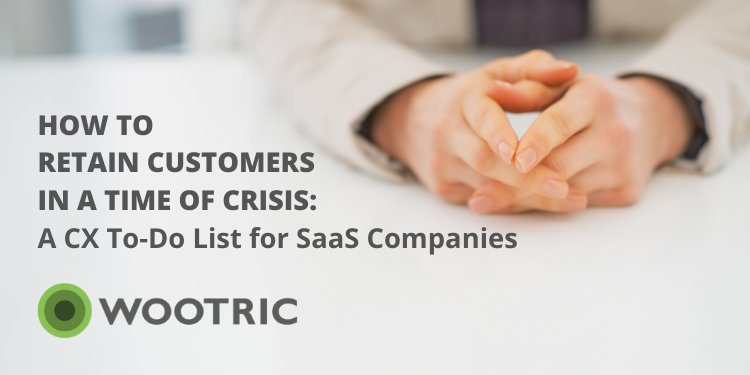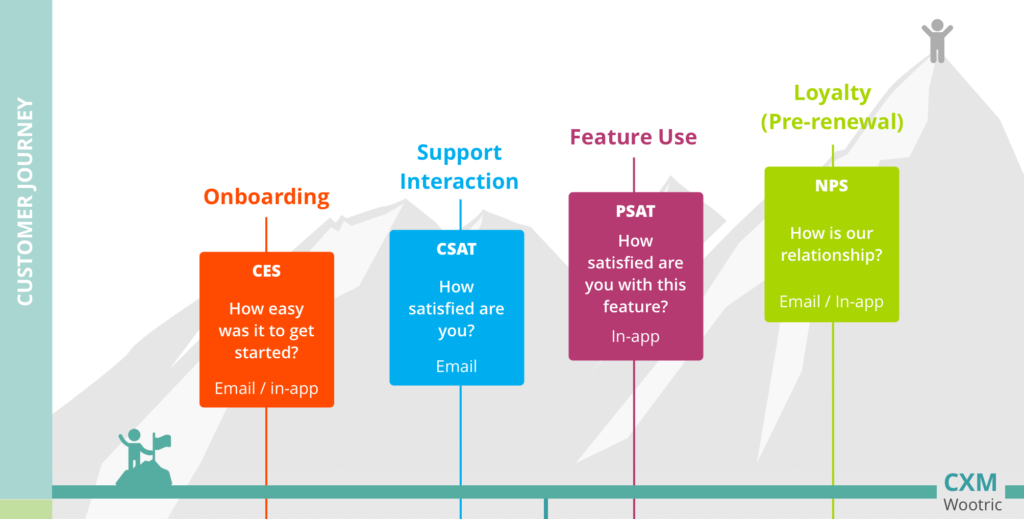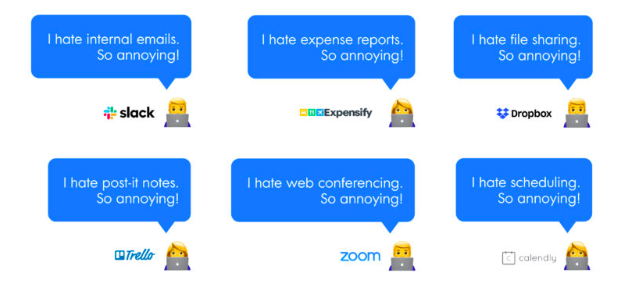How to Retain Customers in a Time of Crisis: A CX To-Do List for SaaS Companies

Financial markets are sliding, a pandemic is spreading around the world, and every company is scrambling to respond to quickly changing circumstances. Planned investments that were intended to drive growth — like hiring, media spend and software purchases — are being reevaluated as business leaders are forced to triage what they need to do to weather the storm. We’re all in survival mode, but survival is about prioritizing what is most important.
And what is most important to a SaaS business at this moment?
It’s not toilet paper.
It’s our existing customers.
Now more than ever, customer experience is job #1.
We think the SaaS businesses that focus on retaining customers and building loyalty are the ones that will survive and thrive in this uncertain climate.
Of course, the question then becomes how do you retain customers and build loyalty?
Shift from a growth mindset to a retention mindset
This may not hold true for every business we work with – Zoom, GrubHub, and the e-commerce toilet paper company Who Gives a Crap are having quite a moment. But most businesses are facing contraction because people don’t buy in a panic. Budgets are being trimmed everywhere, and customer success and renewal conversations must be deeply empathetic to this.
So, if a customer is achieving goals with your software, and you have other features and capabilities that will make them even more successful in 2020, then, by all means, paint a bold vision of an expanded partnership. But, if that isn’t the case, and they want to reduce or leave, don’t come across as tone-deaf. It’s likely that everyone in their company has been asked to find ways to trim spend.
That means that it’s even more important to know that your internal champion can confidently advocate for you – because you are delivering value. Step up your customer success initiatives. Make sure you and your clients are recording successes. And don’t be afraid to change the conversation from trying to get the customer to buy more, to showing him or her how the company can get more value from what they’ve already purchased.
Listen to your customers even more carefully – and respond
Even when you’re focusing on your existing customers, don’t make the mistake of thinking they’re the “same” customers – they’ve changed. We all have. Because our needs change in a downturn. Companies that are on the pulse of those changes by proactively listening are better poised to adapt, innovate, survive, and serve. Make calls to key customers. It’s even more important now than it usually is to listen and respond to concerns quickly.
Take care of your people
Your employees, your teams, are the key to your customer relationships. They may be concerned about their health or the health of their parents, or grandparents. They may be struggling to find childcare options if their schools are shut down. They may be stressed about their 401K balance. Whatever it is, empathy and flexibility are going to be key – and so is prudent business planning. How can you plan to support your employees through these challenges?
Be a good citizen
For the collective good, and for the good of your brand, it’s so important right now to prioritize the good of the community and show conscientious, caring judgment. To do this, you may need to make some tough calls that hit your short-term profits, but protect people. We’re all making sacrifices – the New York Times dropped its paywall for coronavirus news and Zoom is giving K-12 schools free video conferencing. Is there a way your company can help people in need right now? You’ll be remembered for it.
Establish a company policy of flexibility
Just as you have to be flexible with your employees and their quickly-changing challenges, you also have to be flexible as a company. For example, if a client calls customer support to request an extended payment plan, empower your support team to deviate from your standard policies and allow it. Be open to changing how you usually do things if it makes sense and shows compassion. You’ll likely prevent avoidable churn.
Jessica Pfeifer, Chief Customer Officer at Wootric, shared this recent story with our team:
“I just had a customer reach out about putting their subscription on hold. They operate in the hospitality sector which has been particularly hard hit. We offered to work out a plan to enable her to continue to get customer feedback during this critical time. Her response was ‘That would be amazing! Thank you!’ I know we’ve strengthened customer loyalty.”
Customers notice the companies that support them in difficult times, so be flexible when you can, and you’ll build loyalty for the future.
Close the loop with customers when they offer feedback
This may be built into your CX program already, but if not, now is the time to double-down on listening and responding to customers. Ensuring your customers feel heard and cared about in times of high stress carries more weight than when times are easy. So if a customer responds to one of your surveys, be sure to close the loop and let them know you value their time and will take appropriate action.
Customer success managers can reach out one-on-one via email or phone, but that isn’t always practical. Closing the loop can be automated when you have your feedback readily available in systems like Intercom or Salesforce. Here’s a quick guide on how to automate closing the loop on customer feedback.
Improve customer experience at customer journey touchpoints
In SaaS, this often means using an NPS survey to gauge overall loyalty and surface any issues that may affect renewal. To get serious about retention, consider asking for feedback at critical SaaS journey points–after onboarding, support interactions, and during product/feature use.
This isn’t about quickly adding a slew of new surveys overnight; it’s about prioritizing improvements to moments that, if not successful, can sow the seeds of churn. Now is the time to double-down on understanding and improving the customer journey.

Also, remember to analyze the qualitative feedback from these surveys. A customer who is “satisfied” but mentions a concern over price may now be at a higher risk of churn.

Focus product development on reducing friction for existing customers
In the software business, product experience is the all-important driver of customer experience. So, to foster customer loyalty, think about what you can do to create more ease for existing users.
Blake Barlett at OpenView says product-led growth is the key to success in the End User Era. In this era, end user annoyance spells opportunity. Think Slack vs. email, or Zoom vs. Hangouts.
In financially uncertain times, a product-led development philosophy can hold the key to faster end user adoption and increased retention. Tune into those day-to-day annoyances – they hold the key to retention.
Accelerate end user adoption
Happy end users make your application stickier, so if your champion is struggling to persuade others in their company to use your platform, you need to know why. You may need more in-app cues and guidance to make tasks easier. What is “so annoying” about your product? Ask your customers that, and you may find exactly what you need to reduce friction – which will pay off in retention.
Now is the time to deepen relationships and partnerships with promoters
Guneet Singh, Director of Customer Experience programs at Docusign, spoke about this in a recent Voice of the Customer webinar. He looks for champions among his promoters who have a common pain point, and then brings them together in councils that engage with DocuSign’s product team. Through this customer advocacy program, his customers learn from each other, get a first look at new product features, and provide valuable insights for the DocuSign product development roadmap.
How do you begin a customer advocacy program like this? Pay attention to customer requests and “start with small wins,” says Guneet. “If you complete the feature that a customer asks for, by listening and acting on their words, you’ve won that customer for life.”
We couldn’t agree more!
The most valuable commitment we have is to our customers. And as much as we work to grow, to scale, to expand — it’s times like these where we have to remember to appreciate the people who already support us and show them support too. We’re all in this together.
Learn how Pearl-Plaza can help you measure and improve customer experience by scheduling a demo.


